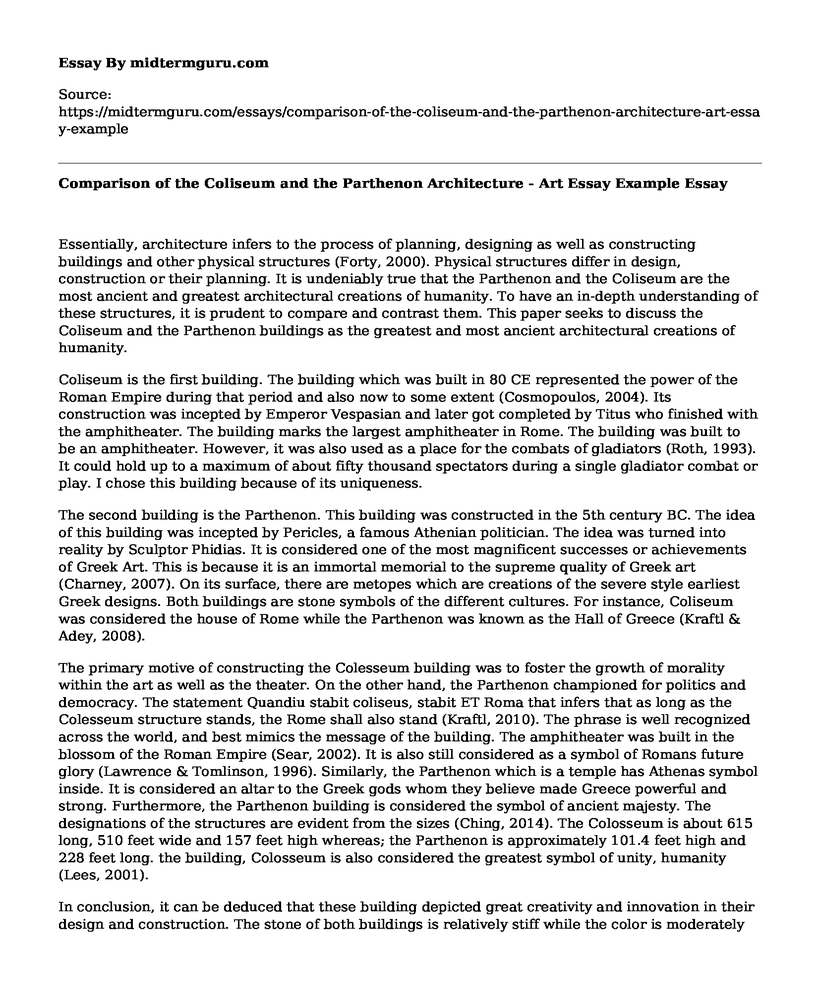Essentially, architecture infers to the process of planning, designing as well as constructing buildings and other physical structures (Forty, 2000). Physical structures differ in design, construction or their planning. It is undeniably true that the Parthenon and the Coliseum are the most ancient and greatest architectural creations of humanity. To have an in-depth understanding of these structures, it is prudent to compare and contrast them. This paper seeks to discuss the Coliseum and the Parthenon buildings as the greatest and most ancient architectural creations of humanity.
Coliseum is the first building. The building which was built in 80 CE represented the power of the Roman Empire during that period and also now to some extent (Cosmopoulos, 2004). Its construction was incepted by Emperor Vespasian and later got completed by Titus who finished with the amphitheater. The building marks the largest amphitheater in Rome. The building was built to be an amphitheater. However, it was also used as a place for the combats of gladiators (Roth, 1993). It could hold up to a maximum of about fifty thousand spectators during a single gladiator combat or play. I chose this building because of its uniqueness.
The second building is the Parthenon. This building was constructed in the 5th century BC. The idea of this building was incepted by Pericles, a famous Athenian politician. The idea was turned into reality by Sculptor Phidias. It is considered one of the most magnificent successes or achievements of Greek Art. This is because it is an immortal memorial to the supreme quality of Greek art (Charney, 2007). On its surface, there are metopes which are creations of the severe style earliest Greek designs. Both buildings are stone symbols of the different cultures. For instance, Coliseum was considered the house of Rome while the Parthenon was known as the Hall of Greece (Kraftl & Adey, 2008).
The primary motive of constructing the Colesseum building was to foster the growth of morality within the art as well as the theater. On the other hand, the Parthenon championed for politics and democracy. The statement Quandiu stabit coliseus, stabit ET Roma that infers that as long as the Colesseum structure stands, the Rome shall also stand (Kraftl, 2010). The phrase is well recognized across the world, and best mimics the message of the building. The amphitheater was built in the blossom of the Roman Empire (Sear, 2002). It is also still considered as a symbol of Romans future glory (Lawrence & Tomlinson, 1996). Similarly, the Parthenon which is a temple has Athenas symbol inside. It is considered an altar to the Greek gods whom they believe made Greece powerful and strong. Furthermore, the Parthenon building is considered the symbol of ancient majesty. The designations of the structures are evident from the sizes (Ching, 2014). The Colosseum is about 615 long, 510 feet wide and 157 feet high whereas; the Parthenon is approximately 101.4 feet high and 228 feet long. the building, Colosseum is also considered the greatest symbol of unity, humanity (Lees, 2001).
In conclusion, it can be deduced that these building depicted great creativity and innovation in their design and construction. The stone of both buildings is relatively stiff while the color is moderately light creating an amazing impression. Both structures are a depiction of two world greatest ancient cultures which are the Greek and Roman cultures (Robertson, 1929). Notably, Colosseum was designed and constructed for everyone; however, the Parthenon was constructed for the selected few. Furthermore, Parthenon had naturalistic elements. However, Colosseum is blocky and reserved. Both have same aspects. However, they do different roles making them different ancient Roman and Greek architectural creations.
References
Charney, I. (2007). The politics of design: architecture, tall buildings and the skyline of central London. Area, 39(2), 195-205.
Ching, F. D. (2014). Architecture: Form, space, and order. John Wiley & Sons.Cosmopoulos, Michael (editor). The Parthenon and its Sculptures. Cambridge University: 2004
Forty, A. (2000). Words and buildings: a vocabulary of modern architecture (Vol. 268). London: Thames & Hudson.
Kraftl, P. (2010). Geographies of architecture: the multiple lives of buildings. Geography Compass, 4(5), 402-415.
Kraftl, P., & Adey, P. (2008). Architecture/affect/inhabitation: geographies of being-in buildings. Annals of the Association of American Geographers, 98(1), 213-231.
Lawrence, A. W., & Tomlinson, R. A. (1996). Greek architecture (Vol. 11). Yale University Press.Lees, L. (2001). Towards a critical geography of architecture: the case of an ersatz colosseum. Ecumene, 8(1), 51-86.
Robertson, D. S. (1929). Greek and Roman architecture. Cambridge University Press.Roth, Leland M. (1993). Understanding Architecture: Its Elements, History, and Meaning, First, Boulder, CO: Westview Press.
Sear, F. (2002). Roman architecture. Routledge.
Cite this page
Comparison of the Coliseum and the Parthenon Architecture - Art Essay Example. (2021, Jun 10). Retrieved from https://midtermguru.com/essays/comparison-of-the-coliseum-and-the-parthenon-architecture-art-essay-example
If you are the original author of this essay and no longer wish to have it published on the midtermguru.com website, please click below to request its removal:
- Essay on the Middle Age Art, Architecture, and Music Relation to the Church
- Films Analysis Essay on "Female Perversions" And "Delirium"
- Essay Sample on Communication and Media
- Movie Analysis Essay on Born This Way
- Temple of Zeus: Ancient Masterpiece of Doric Architecture - Essay Sample
- Smartphone Revolution: A 2011 Primary School Story - Essay Sample
- Reflective Essay on American Museum of Natural History







